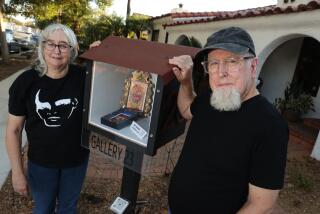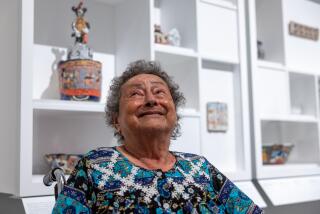Art and Soul
- Share via
When Juan Juarez was a young man, he spent a lot of time hanging out in art galleries here in Laguna Beach. Because he never bought anything--a construction worker’s pay doesn’t go far in the elite shops of this artsy seaside village--he was regularly, not always politely, asked to leave.
And there you have the reason Juan Juarez, who now owns one of those galleries, invited 116 fourth-graders in last week to hang out.
“Hanging out” is not what the administrators at Costa Mesa’s Pomona Elementary school call the program, of course, but that was clearly the idea. As Juarez put it, “The first thing, the most important thing, is to never, ever, be afraid to just walk into a museum or a gallery if for no other reason than to stand there and look at the pictures. After all, isn’t that what it’s there for?”
A small boy in a “Field of Dreams” T-shirt isn’t listening anymore. He’s too busy looking at the pictures. “Look, look here! This one with the big colors--it’s $5,000! Five thou-sand dol-lars!”
A girl from his class is spinning round and round in the center of the polished marble floor. “I’m dizzy from the pictures!” she squeals. “I want to live here!”
This is the largest group of students to visit the Juarez Fine Art Gallery since Juan and his wife, Bernadette, launched their Latin Masters School Program to give Spanish-speaking elementary- and middle-school children in Southern California a way to “meet” painters and sculptors from Mexico, Costa Rica, El Salvador, Guatemala and Brazil, the countries where many of the students at the Costa Mesa school were born.
In preparation for their field trip, teachers talked to the students about the art they would see at the gallery. Later, they plan to “interpret” what they saw on paper in their classrooms--although art supplies there, as in many public schools today, are sparse.
“For some of our children, even driving by the beach was an extraordinary treat,” says teacher Jeri Tannebring. “Even though our school is just a mile and a half from a beach, most of them have never been there. About the gallery, we told them to keep their eyes and ears open. I see this as a way to liberate their imaginations, to see what others have done with their feelings and their life experiences.”
Gabriela Reyes, 9, turns her head upside down to look at an abstract still life. “Oh, I see now,” she says turning her head back. “He put out a plate of fruits in many colors and, then, well--he just tried his best. One time someone said to me if you can create shapes, you can make anything. So, here it is--it’s true.”
Outside in the Juarez Sculpture Garden, a circle of boys is gathered around a set of bronze windmills that spin and whir in the fresh sea breeze. “I like the windmill best and you know why?” Fredy Lopez, 10, asks his younger classmates. “Because it moves all alone. Nobody is touching it or making it do anything. It’s just moving how it wants to move.”
Like critics at an opening, Victor Soto and Benjamin Morales, both 9, hold their chins and nod soberly.
*
Juarez, 44, is a self-taught, highly successful art lover. In the early days when he went to work with a shovel and a bandanna, he had to save many paychecks for a single modest acquisition. Later, as his reputation as a contractor grew and his business boomed, he continued to build his eclectic collection of stone sculpture, pen-and-ink sketches, bold murals, lithographs, even pre-Columbian pottery that caught his eye. If he needed money to feed his family of five children or replace equipment for his construction business, he would sell a piece of art.
Then in 1990, he returned to one of the galleries off Forest Avenue here that had asked him to leave more than once, and he bought it.
“Art is anything--that’s the lesson for today, boys and girls,” Juarez told the students as they lined up to leave.
“Art is a dream put down on paper or molded into a statue. It’s a bubbling fountain or a tiny garden. When you get back on those big yellow buses to go home today, take this message with you: Art is like your thoughts; it has no boundaries and no rules.”
“And, don’t forget,” added the Irish-born Bernadette, 39. “Never hesitate to go through the door. You are important and you have the right to walk into any gallery, any museum.
“The Juarez Gallery with all this beautiful, valuable art, is proof of that. This was Juan Juarez’s dream and because he kept on coming back, even when they threw him out, he made his dream come true.”
More to Read
The biggest entertainment stories
Get our big stories about Hollywood, film, television, music, arts, culture and more right in your inbox as soon as they publish.
You may occasionally receive promotional content from the Los Angeles Times.










